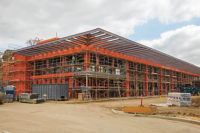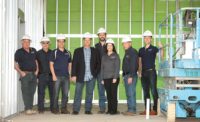Although it’s based out of Orange, Calif., The Raymond Group has a much farther reach. Without a doubt one of the most successful wall and ceiling contractors in the nation, the company operates in the western U.S. (including Hawaii). For those not familiar with the company, Raymond Group is a full service, design-assist, and specialty finish contractor. A lot of blood, sweat and muscle have made that a reality. Allow us to introduce you to how that began.
Founded in 1936 by George M. Raymond, originally the company was a lath and plaster contractor. In the 1940s, Raymond Group earned the contract for the City of Lakewood’s plastering at one of the first large scale housing developments. This provided George with the opportunity to grow and expand the company. By the 1950s, the company’s operations extended into commercial contracts, completing noteworthy projects in Greater Los Angeles, such as the Pioneer Savings and Loan Association Building on Wilshire Boulevard and more.
In 1968—with the influence of George’s son Carl Raymond—the company began a drywall division, which quickly grew and within 10 years had surpassed the lath and plaster sales.
The company prides itself in being at the forefront of change: it has embraced design-assist, BIM, integrated project delivery, prefabrication, and automated site manufacturing among others. Raymond Group has gained abundant experience in many different markets becoming an expert go-to contractor in education, entertainment and attraction, historical restoration, healthcare, OSHPD, office core and shell, retail, tenant improvement, and highly themed hotels and casinos, to name a handful.
As this company’s growth continues amongst change, adapting to economic pulls and industry trends, it remains a family-owned company, operating with the same core values instilled by its founders.
Last year, Raymond Group announced an affiliation with Sto Corp. As a Sto Panel Technology Affiliate, the subcontractor is provided with immediate access to a larger national experience and knowledge base, and is able to offer prefabricated wall panel systems that provide greater value and quality to its customers and are installed in a safer and more productive manner. Prefabrication and implementation of technology and trade coordination are some of the hallmarks of the services the company provides to its customers.
Today, Raymond Group sustains five full-service offices located throughout California, Nevada, and Washington; each sharing vital resources with a national network, including a strong central information system, giving clients a high degree of confidence that overall project goals can be met. The company currently has 150 office employees and a whooping 800 field employees.
A Dynamic History
As for current CEO Travis Winsor’s involvement in the trades, it wasn’t planned. Winsor had been practicing civil litigation for five years when he decided to go back to school. He made the commitment to pursue his Master of Business Administration without the intent of working for the family business but knew that he did want to move into more of a business environment. When Carl Raymond (who retired in 2003 due to health concerns) offered him a position, a new perspective was presented and Winsor thought of a different point of view.
“Having been in business for over 78 years, Raymond Group has experienced many business cycles which have caused it to expand and contract,” says Winsor, who also runs the company with other senior members, including President and COO Jim Watson (see cover). “Clearly, the organization has grown since its inception by George Raymond, but more recently the company has been through some volatile cycles. Between 2005 and 2008, when the construction market was very strong, Raymond rode the robust economy and grew to a record size for the organization. As with many construction companies, the recession hit Raymond very hard and contraction was necessary to survive. At the lowest point of the recession, Raymond Group was less than 30 percent of its record size. Adjusting the structure of the organization for ‘The New Reality’ of the recession taught all of us many valuable lessons and made us look at our industry differently.”
Today, the subcontractor is enjoying an improving market; but things aren’t at a level yet that Winsor—nor the company—want: work is much slower to grow and margins continue to be depressed, he says. “This fiscal year Raymond will be approximately two-thirds the size of the high water mark,” says Winsor. “Our goal is not to grow in size but to become more efficient in all of Raymond’s operations to improve profitability.”
Overall, Raymond Group has seen increasing backlogs in the past two to three quarters which forecast improved construction activity for 2015.
Winsor states that San Francisco and Los Angeles are experiencing significant construction activity and based on the subcontractor’s current backlog, sectors including hospitality, multi-family residential and privately-funded education projects should remain strong for the next few years.
“In comparison to San Francisco and Los Angeles, the San Diego market is rebounding at a slow pace, and the Las Vegas market, even slower,” Winsor says. “Raymond Group’s newest office in Seattle has also seen an improvement in the market conditions but the competition from non-union firms and aggressive owners have held the margins to very low levels.”
While construction activity is increasing in each of Raymond’s market areas, low margins are still prevalent. The potential for volume is there, but it comes with the concern that there won’t be sufficient margins available to sustain it.
The wall and ceiling industry is one that is always evolving and presenting new challenges. No two days are the same, we are exposed to many great people and the best pre-planned schedules are subject to change to address a new situation. This creates an environment that is exciting and very entrepreneurial. It is mentally stimulating to work on issues with a dynamic team to develop the best strategy for serving the client’s needs, adhering to Raymond’s values and remaining profitable.
Yet surely running a business of this size and magnitude isn’t the easiest ship to sail: when Raymond had to contract during the recession to survive, this involved some very tough and personal decisions, says Winsor, as the company has always prided itself on its family environment.
‘“Contraction’ is a sterile way to describe separating from many good, talented people that are part of your life,” says Winsor. “The enormity of the task was painful during the recession but it was a matter of survival. Nevertheless, making those decisions which have a significant impact on the lives of people and their families even in good times is difficult.”
Market Share
Based on Raymond Group’s massive success, one would think it wouldn’t be hard to entice new employees—specifically those in the field—given this particular company’s history, record and legacy. Yet, Raymond Group does have to work to secure a workforce so that the supply will handle the demand. The company has been seeing an increase in competition (possibly a correlation to the tight margins), some of which is coming from non-union contractors breaking into markets historically marked as union. Non-union contractors as a whole are becoming more sophisticated and are taking on more challenging projects. Union market share is declining in areas traditionally served by the subcontractor.
Due mostly to the recent recession, and particularly in Southern California, there is a real potential for a skilled labor shortage—hardly news for anyone operating in North America. As construction activity increases and Raymond Group rebuilds its backlog, it is important to look at ways of retaining top management and field crews to meet project needs through 2015 and beyond, says Winsor.
“It is more important now to carefully manage the work acquisition strategy so that it is in alignment with available internal resources,” he says. The company not only relies upon its labor partners but also actively recruits for all levels of management. Especially during uncertain times, it is important to focus and build upon good quality people, Winsor says. Retaining key top management and field crews to meet the project needs should be the top priority for any company of this scope and size.
For any contractor reading this, step back and take note if you want to build a business model that will last to the next generation. Certainly, there are a lot of factors that can determine success and some things are simply out of one’s control. But if you consider the longevity of companies like Raymond Group, you’ll find an operation that is always trying to be several steps ahead of the game. One of these steps is embracing technology.
“Today, technology is being used on a larger scale and is being implemented at a more rapid pace on all project types. Success is contingent upon a firm’s ability to properly evaluate and implement relevant processes and improvements in this area,” says Winsor. “BIM, IPD and prefabrication strategies depend on a company’s ability to embrace technology and change. This will be key to Raymond’s success in the future.”
Raymond makes a strong effort to put different trades together on a common task. There’s a tremendous amount of teamwork and a lot of structure imposed in terms of monitoring, scheduling and knowing where the project will end up financially.
Associations and Affiliations
Raymond Group is a member and holds certifications with various associations:
- Air Barrier Association of America - Licensed Air Barrier Contractor
- American Society for Healthcare Engineering of the American Hospital Association
- The American Society of Safety Engineers
- Association of the Wall and Ceiling Industry - EIFSmart Contractor
- National Fireproofing Contractors Association - Qualified Spray Applied Fire Resistive Material Contractor
- National Safety Council
- Northern California Drywall Contractors Association
- Northwest Wall & Ceiling Bureau
- Parex USA Medallion Applicator
- Scaffold & Access Industry Association
- Sto Panel Technology
- U.S. Green Building Council
- Western Wall & Ceiling Contractors Association
Raymond Rents
To acquire automatic taping tools, contractors have two options—renting or buying. Just like purchasing a car, tool ownership is often perceived as the more economical option. But in fact, some contractors have found that tools, like automobiles, only depreciate in value.
One such professional is Jim Hawse, field superintendent for Raymond Group.
“Tool rental saves us between 10 and 15 percent on our costs,” explains the 38-year drywall veteran who chooses to rent from AMES Taping Tools. “These job-ready tools maximize our crew’s time actively finishing—the goal for any productive drywall finisher. Moreover, margins are extremely narrow these days, so anything you can save adds to the bottom line.”
Hawse’s Las Vegas division owned ATF tools for more than two decades before shifting to rental agreements in 2009.
“We owned our own tools and augmented large jobs with spot rentals,” recalls Hawse. “It took us time to appreciate the fact that tools—whether we own or rent them—are only profitable when they are running at top efficiency.”
“Instead of working harder to compensate for a tool operating at 75 percent capacity, we want that same finisher to finish 20 percent more board feet each day,” continues Hawse. “This way, the same crew is able to complete more jobs, which leads to greater profits.”
Unlike Hawse, his Golden State counterpart, Brent Christensen, has leveraged the benefits of tool rental for decades. In his 20 years with Raymond’s Northern California division, Christensen has always preferred for his crews to use rental equipment to avoid what he terms the “maintenance productivity thief.”
For contractors who properly maintain their personal tools, outright purchase of automatic taping equipment is ideal, as it provides reliable performance with a relatively low investment, says Christensen. Routine cleaning, lubricating and replacement of standard wear parts keep tools operating at peak performance.
“For that equally conscientious contractor who must share his tools with larger crews, a rental arrangement assures that no matter who last ran a particular tool; it can be changed out, at no cost, for a clean, fully-calibrated tool,” says Christensen.
According to Christensen, the productivity thief is found in between these two scenarios. “The contractor who purchases tools—with the best intentions—but, due to work load or compressed schedules, cannot properly maintain them,” continues Christensen. “This contractor is forced to make due and compensate for a poorly performing or broken tool by working additional hours or overstaffing a job.”
MAXIMIZING TIME ON WALL
He notes that a defective tool that has been held together with duct tape, wire or rubber bands inevitably results in decreased productivity, substandard quality, time-consuming repetitions or job site injuries.
As an example, Christensen points to an automatic taper that is mis-feeding tape or joint compound. “How much time will workers waste compensating for this defective tool?” He questions. “Why do I want to pay a union taper $60 to $80 an hour to repair a tool? I want our crews to spend all of their time ‘on the wall.’”
Hawse echoes Christensen’s reasoning.
“If my contractor accidently drops a tool on the job and it breaks, there’s no need to waste time waiting for parts or repairs,” notes Hawse. “The contractor can simply drive to the nearest store and obtain a replacement, job-ready tool under our rental program, and within 30 minutes he’s back up to 100 percent efficiency.”
Although time is still lost having to drive to the store to acquire a replacement, it’s far less downtime than trying to repair the tool on the job site. To improve efficiency further, some of Raymond’s project managers keep extra tools on hand in case of such an emergency.
“If you figure that the annual cost of a Bazooka automatic taper is roughly $900 to rent or about $1,300 to purchase, it’s cheaper for us to rent as you always have a fully-calibrated, job-ready tool without paying for any maintenance,” asserts Hawse.
Admittedly, renting tools can be a balancing act. A contractor does not want to accidently rent more tools than needed. To help avoid such situations, AMES sends a weekly email synopsis of all rented tools per project.
“Our weekly inventory control summaries are especially convenient,” says Christenson, “If I have three guys on a job, and see five tool sets allocated, I know something is wrong.”
In the end, tool ownership is the responsibility of each individual. Larger operations typically leverage the efficiencies and services associated with rental agreements, while many individual contractors prefer the familiarity of their own tools. Just like choosing the right tool for the job, professional finishers know that enhanced productivity, improved finish quality and job site savings can be found right in their own job box.
Surf City
An exciting and important job Raymond Group recently tackled is The Pacific City project, located in Huntington Beach, Calif. This property is made up of nine retail buildings, spanning 11 acres of oceanfront real estate and 191,000 square-feet of open-air shopping and dining space. The new center, owned by DJM Capital Partners, when complete will include more than 50 shops and boutiques, a marketplace, residences featuring 516 luxury apartment homes, and a 250-room boutique hotel. The $135 million development is set to open later this year.
The company was contracted by C.W. Driver to perform the framing, drywall, lath and plaster, fireproofing, and wood exterior finish on all nine buildings. The company used products from CEMCO, BMI, Merlex, Georgia-Pacific Gypsum, Westpac, James Hardie to name a few. Westside Building Materials served as a supplier on the project.
DJM Capitals Partners, along with SMS Architects, designed Pacific City to fit into its surrounding. The construction team worked hard to capture the essence of “Surf City,” creating a balance that would call to tourists and please locals. With the highest quality in mind, the design could be called “beach-like” with light-colored plaster and sharp accents, such as dark plaster and natural materials (wood and stone). Despite the ease with which these buildings will fit in with their neighbors, they will embrace their own flare. Each building is different from the other, including the varying array of finishes, interior layout and total functionality.
“The plaster and wood finishes throughout each building are incredible,” says Winsor. “While the plaster finish could stand on its own, it is dotted with unique wood finishes varying from Douglas fir to reclaimed barn wood siding. The result is a laid-back, beach house vibe with modern influences.”














